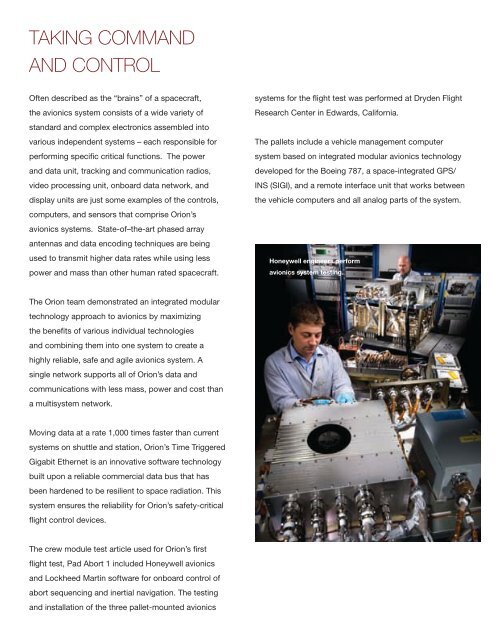Orion: America's Next Generation Spacecraft (4.7 Mb PDF) - NASA
Orion: America's Next Generation Spacecraft (4.7 Mb PDF) - NASA
Orion: America's Next Generation Spacecraft (4.7 Mb PDF) - NASA
You also want an ePaper? Increase the reach of your titles
YUMPU automatically turns print PDFs into web optimized ePapers that Google loves.
TAKING COMMAND<br />
AND CONTROL<br />
Often described as the “brains” of a spacecraft,<br />
the avionics system consists of a wide variety of<br />
standard and complex electronics assembled into<br />
various independent systems – each responsible for<br />
performing specific critical functions. The power<br />
and data unit, tracking and communication radios,<br />
video processing unit, onboard data network, and<br />
display units are just some examples of the controls,<br />
computers, and sensors that comprise <strong>Orion</strong>’s<br />
avionics systems. State-of–the-art phased array<br />
antennas and data encoding techniques are being<br />
used to transmit higher data rates while using less<br />
power and mass than other human rated spacecraft.<br />
systems for the flight test was performed at Dryden Flight<br />
Research Center in Edwards, California.<br />
The pallets include a vehicle management computer<br />
system based on integrated modular avionics technology<br />
developed for the Boeing 787, a space-integrated GPS/<br />
INS (SIGI), and a remote interface unit that works between<br />
the vehicle computers and all analog parts of the system.<br />
Honeywell engineers perform<br />
avionics system testing.<br />
The <strong>Orion</strong> team demonstrated an integrated modular<br />
technology approach to avionics by maximizing<br />
the benefits of various individual technologies<br />
and combining them into one system to create a<br />
highly reliable, safe and agile avionics system. A<br />
single network supports all of <strong>Orion</strong>’s data and<br />
communications with less mass, power and cost than<br />
a multisystem network.<br />
Moving data at a rate 1,000 times faster than current<br />
systems on shuttle and station, <strong>Orion</strong>’s Time Triggered<br />
Gigabit Ethernet is an innovative software technology<br />
built upon a reliable commercial data bus that has<br />
been hardened to be resilient to space radiation. This<br />
system ensures the reliability for <strong>Orion</strong>’s safety-critical<br />
flight control devices.<br />
The crew module test article used for <strong>Orion</strong>’s first<br />
flight test, Pad Abort 1 included Honeywell avionics<br />
and Lockheed Martin software for onboard control of<br />
abort sequencing and inertial navigation. The testing<br />
and installation of the three pallet-mounted avionics
















